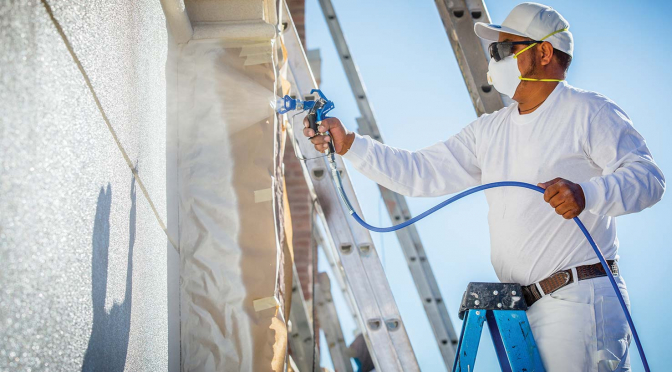Choose the most productive spray tip for your job
Your paint sprayer can help deliver maximum productivity and efficiency — not to mention a premium finish — but only if the spray tip you’ve selected matches the task at hand and the materials you’ll be applying.
“The tip determines how much fluid will leave the gun when you pull the trigger,” advises Graco Director of Sales Brandon Barth. “Choosing the right tip will directly impact exactly how much time and money you can save on a given job.”
Choosing the right tip starts with a basic understanding of what those numbers mean. The three-digit identifier commonly associated with spray tips indicates the following:
- The first digit is ½ the width of the applied paint when sprayed from 12 inches away from a substrate. This width is also called a fan width.
- The second two digits are the size of the tip opening, or orifice, in thousandths of an inch. The larger the orifice, generally the greater the amount of paint applied in that fan width.
Taken together the tip size gives you a relative idea of how much paint you’ll be putting on. A wider fan pattern and larger orifice will apply more paint than a smaller fan pattern and orifice, all other things being equal.
For example, a tip with 517 as its three-digit identifier would have a fan width of 10 inches (5×2) when sprayed a distance of 12 inches from the surface and have an orifice size of .017 inch. A 317 tip would have a fan width of 6 inches (3×2) and because the orifice size is the same (.017 inch), the mil build of the paint will be greater than that applied by a 517 tip presuming your flow rate and pressure are the same. Your flow rate will vary based on your spraying pressure and the material you are using.
With an understanding of the tip size, you can match it to the coatings you’ll be applying. Thinner-bodied coatings, such as lacquers or stains, should use a .009-.013 tip size; oil-base paints, .013-.015; latex paints, .015-.019; heavy latex and smooth elastomerics, .021-.025; and elastomerics and block fillers, .025-.039.
These are typical ranges for the most common coatings, but you may find that a specific tip and pump combination works best for you.
A good starting point to narrow down tip size for your projects is to review the recommendations provided by the coating manufacturer on the container or product specification sheet. Additionally, your sprayer will have a tip rating. This can be found in your sprayer manual or on the manufacturer website. Make sure your sprayer can support the tip size you plan to use.
Worn tips can cost you in ways you may not notice, Barth advises. Using a worn tip will result in an increase in paint usage up to 25 percent as more paint gets lost to overspray. A worn tip can also increase application time by 20 percent, in part by producing a poor quality, uneven finish. Barth suggests operating at the lowest pressure possible that produces an even, productive spray. This will ensure the longest life and least wear out of both your tip and your spray pump.
Manufacturers also uses a color-coding system to help identify spray tips. Graco’s general use tips are blue or black; fine finish low-pressure tips, such as those used for cabinetry and woodworking, are green; high-pressure, heavy-duty tips are grey.
You’ll also find letter codes that indicate special tip features. Titan Tool tips, for example, use the HEA designation to indicate High Efficiency Airless operation. Graco’s RAC tips feature its Reverse-a-Clean feature, which allows users to clear tip clogs by simply reversing the tip flow valve and triggering the sprayer. Other indicators, such as RAC X FF LP, indicate fine-finish, low-pressure capabilities that operate at 50% lower pressure, which can double tip life. WR (Wide RAC) tips deliver extra-wide spray patterns for high production capabilities, and XHD tips are designed for heavier coatings that require higher pressures to atomize.
Whatever your spraying application, make sure you have a tip that’s properly suited for the coatings and equipment you’re using. The result will be measured in improved productivity and profitability.

